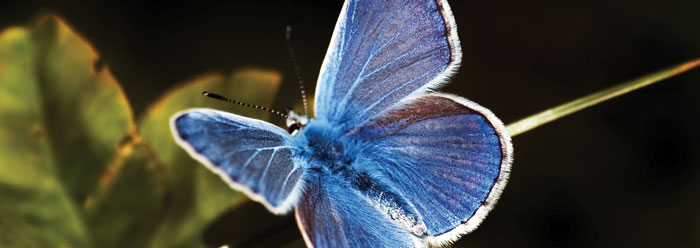The phylum Arthropoda is composed of creatures that have paired, jointed appendages and a chitinous (nitrogen-containing polysaccharide) exoskeleton. It is the largest group of animals in God’s creation and includes the crustaceans (lobsters, crabs) and insects.
Arthropods, like all other creatures, validate the creation model by appearing suddenly and completely in the fossil record in a most un-Darwinian manner.1 A recent discovery of a fossil in Brazil has frustrated evolutionists by being a 100-percent cricket that "has undergone very little evolutionary change since the Early Cretaceous Period."2 Evolution means change, but "100 million years" of stasis hardly validates evolutionary theory. This fossil shows that crickets have always been crickets.
A laboratory insect used for over a century by geneticists is the fruit fly.3 In 2010, researchers reported in the evolutionary journal Nature the results of 600 generations of artificial selection on this creature.4 They were hoping to document beneficial mutations becoming fixed in the fruit fly population. But intelligent agents with plenty of research money and time, working under conditions that would evidently favor upward, onward evolution, could not document beneficial mutations. In fact, the opposite occurred with the flies undergoing "reverse evolution"! In addition, the mystical process of natural selection was conspicuously absent. The study authors wrote:
Our work provides a new perspective on the genetic basis of adaptation. Despite decades of sustained selection in relatively small, sexually reproducing laboratory populations, selection did not lead to the fixation of newly arising unconditionally advantageous alleles.5
What about the recent assertion by Carl Zimmer that a certain butterfly evolution theory has been "vindicated"?6 Zimmer described Polyommatus blue butterflies and ideas that Vladimir Nabokov presented in the 1940s regarding their waves of migration and reclassification. But a careful reading of the account showed no documentation of non-butterflies becoming butterflies. Instead, the report showed only that Nabokov was correct regarding his predictions of the migration of the Polyommatus blue butterflies and their subsequent variation as they filled ecological niches. Variation within the created kind and programmed filling are predicted on the basis of biblical creation.7
Bed bugs have crept into the news recently not only as increasingly unwelcome guests in motel bedding, but also as supposed evidence of "rapid evolution" as they respond to pesticides.8 But do the changes in bed bug survival tactics show that they evolved from an entirely different creature, or are bed bugs just adapting? The latter is a more scientific interpretation, considering they are still the same species of ectoparasite. In Evolution Under the Microscope, David Swift ably discusses an insect’s ability to develop resistance to pesticides9…an ability that has nothing to do with Darwin’s "descent with modification."
Finally, if regularly finding soft tissue in fossils isn’t bad enough for the evolutionary timeline,10 science just delivered another blow to evolution’s alleged long ages. Fossilized arthropod remains from the Paleozoic, a "310-million-year-old" scorpion cuticle and a "417-million-year-old" scorpion-like arthropod, were found to contain exoskeleton remnants. Specifically, "contrary to conventional belief, remains of chitin-protein complex…structural materials containing protein and polysaccharide…are present in abundance."11 Biblical creationists, having trusted in the Bible’s timeline, are not surprised by such discoveries of original organic materials, as they are plain indicators of a young earth.
References
- Sherwin, F. 2005. Butterflies vs. Macroevolution. Acts & Facts. 34 (2).
- Yates, D. Rare insect fossil reveals 100 million years of evolutionary stasis. University of Illinois press release, February 3, 2011.
- Sherwin, F. 2006. Fruit Flies in the Face of Macroevolution. Acts & Facts. 35 (1).
- Burke, M. K. et al. 2010. Genome-wide analysis of a long-term evolution experiment with Drosophila. Nature. 467 (7315): 587-590.
- Ibid.
- Zimmer, C. Nonfiction: Nabokov Theory on Butterfly Evolution Is Vindicated. The New York Times, January 25, 2011.
- Johnson, J. J. S. 2010. Survival of the Fitted: God’s Providential Programming. Acts & Facts. 39 (10): 17-18.
- Hotz, R. L. Why Bedbugs Won’t Die. Wall Street Journal, January 20, 2011.
- Swift, D. W. 2002. Evolution Under the Microscope. Stirling, UK: Leighton Press, 236-239.
- Thomas, B. 2010. The Mysteries of Stunning Soft Tissue Finds. ICR News. Posted on icr.org December 20, 2010.
- Unexpected exoskeleton remnants found in Paleozoic fossils. Carnegie Institution for Science press release, February 7, 2011.
* Mr. Sherwin is Senior Science Lecturer at the Institute for Creation Research.
Cite this article: Sherwin, F. 2011. Insects in Darwin’s Ointment. Acts & Facts. 40 (4): 16.














